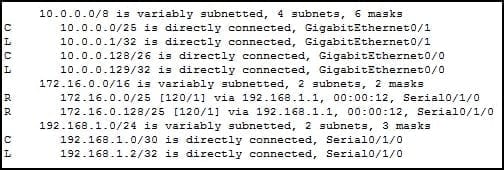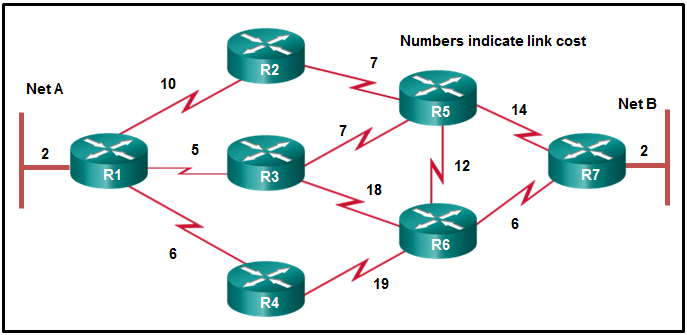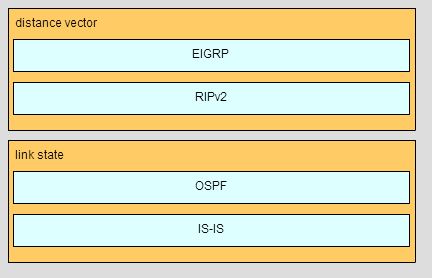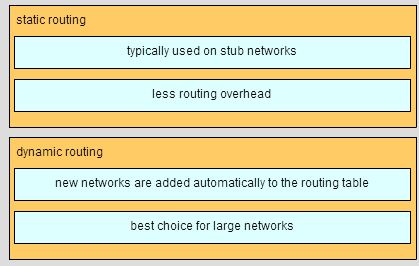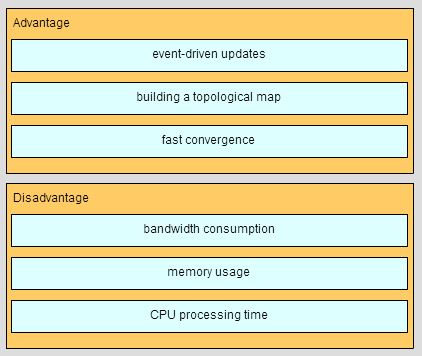Last Updated on April 3, 2018 by Admin
CCNA 2 Chapter 7
From year to year, Cisco has updated many versions with difference questions. The latest version is version 6.0 in 2018. What is your version? It depends on your instructor creating your class. We recommend you to go thought all version if you are not clear. While you take online test with netacad.com, You may get random questions from all version. Each version have 1 to 10 different questions or more. After you review all questions, You should practice with our online test system by go to "Online Test" link below.
-
What is the purpose of the passive-interface command?
- allows a routing protocol to forward updates out an interface that is missing its IP address
- allows a router to send routing updates on an interface but not receive updates via that innterface
- allows an interface to remain up without receiving keepalives
- allows interfaces to share IP addresses
- allows a router to receive routing updates on an interface but not send updates via that interface
-
What two tasks do dynamic routing protocols perform? (Choose two.)
- discover hosts
- update and maintain routing tables
- propagate host default gateways
- network discovery
- assign IP addressing
-
Which route is the best match for a packet entering a router with a destination address of 10.16.0.2?
- S 10.0.0.0/8 [1/0] via 192.168.0.2
- S 10.16.0.0/24 [1/0] via 192.168.0.9
- S 10.16.0.0/16 is directly connected, Ethernet 0/1
- S 10.0.0.0/16 is directly connected, Ethernet 0/0
-
Which two statements describe the OSPF routing protocol? (Choose two.)
- automatically summarizes networks at the classful boundaries
- has an administrative distance of 100
- calculates its metric using bandwidth
- uses Dijkstra’s algorithm to build the SPF tree
- used primarily as an EGP
-
Which two statements are true regarding classless routing protocols? (Choose two.)
- sends subnet mask information in routing updates
- sends complete routing table update to all neighbors
- is supported by RIP version 1
- allows for use of both 192.168.1.0/30 and 192.168.1.16/28 subnets in the same topology
- reduces the amount of address space available in an organization
-
What two actions result from entering the network 192.168.1.0 command in RIP configuration mode on a router? (Choose two.)
- The network address 192.168.1.0 is advertised to the neighbor routers.
- Routing updates are sent through all the interfaces belonging to 192.168.1.0.
- The routing table is created in the RAM of the router.
- The RIP process is stopped and all existing RIP configurations are erased.
- The neighboring routers are sent a request for routing updates.
-
Refer to the exhibit. Based on the partial output from the show ip route command, what two facts can be determined about the RIP routing protocol? (Choose two.)
- RIP version 2 is running on this router and its RIP neighbor.
- The metric to the network 172.16.0.0 is 120.
- RIP version 1 is running on this router and its RIP neighbor.
- The command no auto-summary has been used on the RIP neighbor router.
- RIP will advertise two networks to its neighbor.
-
Which dynamic routing protocol was developed as an exterior gateway protocol to interconnect different Internet providers?
- BGP
- EIGRP
- OSPF
- RIP
-
In the context of routing protocols, what is a definition for time to convergence?
- the amount of time a network administrator needs to configure a routing protocol in a small- to medium-sized network
- the capability to transport data, video, and voice over the same media
- a measure of protocol configuration complexity
- the amount of time for the routing tables to achieve a consistent state after a topology change
-
Refer to the exhibit. OSPF is used in the network. Which path will be chosen by OSPF to send data packets from Net A to Net B?
- R1, R2, R5, R7
- R1, R3, R5, R7
- R1, R3, R6, R7
- R1, R4, R6, R7
- R1, R3, R5, R6, R7
-
A destination route in the routing table is indicated witha code D. Which kind of route entry is this?
- a static route
- a route used as the default gateway
- a network directly connected to a router interface
- a route dynamically learned through the EIGRP routing protocol
-
Refer to the exhibit. Which interface will be the exit interface to forward a data packet with the destination IP address 172.16.0.66?
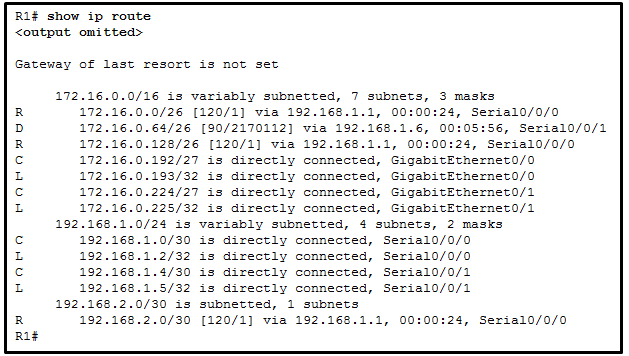
CCNA 2 Chapter 7 Exam Answer 003
- Serial0/0/0
- Serial0/0/1
- GigabitEthernet0/0
- GigabitEthernet0/1
-
Which two events will trigger the sending of a link-state packet by a link-state routing protocol? (Choose two.)
- the router update timer expiring
- a link to a neighbor router has become congested
- a change in the topology
- the initial startup of the routing protocol process
- the requirement to periodically flood link-state packets to all neighbors
-
Which two requirements are necessary before a router configured with a link-state routing protocol can build and send its link-state packets? (Choose two.)
- The router has determined the costs associated with its active links.
- The router has built its link-state database.
- The routing table has been refreshed.
- The router has established its adjacencies.
- The router has constructed an SPF tree.
-
Which two requirements are used to determine if a route can be considered as an ultimate route in a router’s routing table? (Choose two.)
- contain subnets
- be a default route
- contain an exit interface
- be a classful network entry
- contain a next-hop IP address
-
What is different between IPv6 routing table entries compared to IPv4 routing table entries?
- IPv6 routing tables include local route entries which IPv4 routing tables do not.
- By design IPv6 is classless so all routes are effectively level 1 ultimate routes.
- The selection of IPv6 routes is based on the shortest matching prefix, unlike IPv4 route selection which is based on the longest matching prefix.
- IPv6 does not use static routes to populate the routing table as used in IPv4.
-
Which route will a router use to forward an IPv4 packet after examining its routing table for the best match with the destination address?
- a level 1 child route
- a level 1 parent route
- a level 1 ultimate route
- a level 2 supernet route
-
Fill in the blank. Do not abbreviate.
When configuring RIPng, the default-information originate command instructs the router to propagate a static default route.
-
Fill in the blank. Do not abbreviate the answer.
The command version 2 is used in RIP router configuration mode to enable the sending of subnet masks with the routing updates.
-
Match the routing protocol to the corresponding category. (Not all options are used.)
-
Match the characteristic to the corresponding type of routing. (Not all options are used.)
-
Match the features of link-state routing protocols to their advantages and disadvantages. (Not all options are used.)
From year to year, Cisco has updated many versions with difference questions. The latest version is version 6.0 in 2018. What is your version? It depends on your instructor creating your class. We recommend you to go thought all version if you are not clear. While you take online test with netacad.com, You may get random questions from all version. Each version have 1 to 10 different questions or more. After you review all questions, You should practice with our online test system by go to "Online Test" link below.
